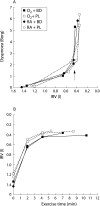Combined physiological effects of bronchodilators and hyperoxia on exertional dyspnoea in normoxic COPD
- PMID: 16467067
- PMCID: PMC2104668
- DOI: 10.1136/thx.2005.053470
Combined physiological effects of bronchodilators and hyperoxia on exertional dyspnoea in normoxic COPD
Abstract
Background: Studies examining the physiological interactions of oxygen (O(2)) and bronchodilators (BD) during exercise in chronic obstructive pulmonary disease (COPD) should provide new insights into mechanisms of exercise intolerance. We examined the effects of O(2) and BD, alone and in combination, on dyspnoea, ventilation (e), breathing pattern, operating lung volumes, and exercise endurance.
Methods: In a randomised, double blind, crossover study, 16 patients with COPD (mean (SE) FEV(1) 43(3)% predicted) performed pulmonary function tests and an incremental exercise test, then completed four visits in which they received either nebulised BD (ipratropium 0.5 mg + salbutamol 2.5 mg) or placebo (PL) with either 50% O(2) or room air (RA). After 90-105 minutes the patients performed pulmonary function tests, then breathed RA or O(2) during symptom limited constant load exercise at 75% peak work rate.
Results: With BD the mean (SE) increase in inspiratory capacity (IC) was 0.3 (0.1) l (p<0.05) at rest and during exercise, permitting greater tidal volume (Vt) expansion during exercise and a greater peak e. With O(2), e decreased during exercise as a result of decreased breathing frequency (F), with no significant change in IC. During exercise with BD+O(2), IC and Vt increased, F decreased, and e did not change. Dyspnoea decreased with all interventions at a standardised time during exercise compared with PL+RA (p<0.05). Endurance time was significantly (p<0.05) greater with BD+O(2) (10.4 (1.6) min) than with O(2) (8.5 (1.4) min), BD (7.1 (1.3) min) and PL+RA (5.4 (0.9) min).
Conclusion: By combining the benefits of BD (reduced hyperinflation) and O(2) (reduced ventilatory drive), additive effects on exercise endurance were observed in patients with normoxic COPD.
Conflict of interest statement
Competing interests: none.
Comment in
-
Combination therapy for exercise intolerance in COPD.Thorax. 2006 Jul;61(7):551-2. doi: 10.1136/thx.2006.058511. Thorax. 2006. PMID: 16807386 Free PMC article.
References
-
- Celli B R, MacNee W, and committee members Standards for the diagnosis and treatment of patients with COPD: a summary of the ATS/ERS position paper. Eur Respir J 200423932–946. - PubMed
-
- O'Donnell D E, Lam M, Webb K A. Measurement of symptoms, lung hyperinflation and endurance during exercise in chronic obstructive pulmonary disease. Am J Respir Crit Care Med 19981581557–1565. - PubMed
-
- O'Donnell D E, Lam M, Webb K A. Spirometric correlates of improvement in exercise performance after anticholinergic therapy in chronic obstructive pulmonary disease. Am J Respir Crit Care Med 1999160542–549. - PubMed
Publication types
MeSH terms
Substances
LinkOut - more resources
Full Text Sources
Other Literature Sources
Medical





